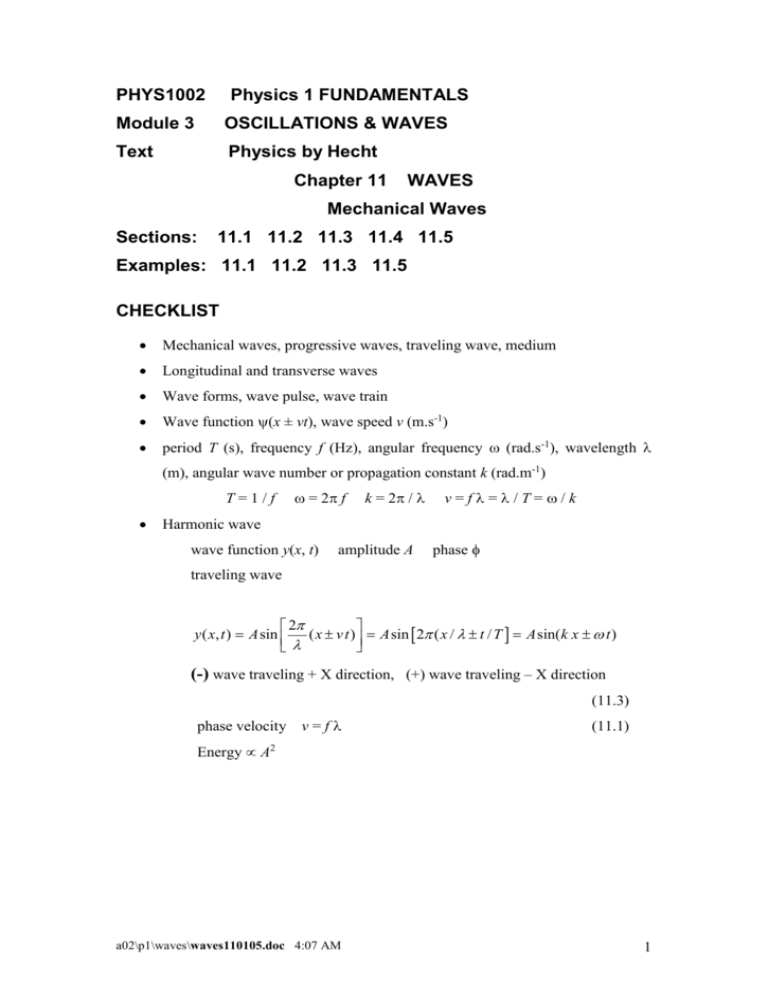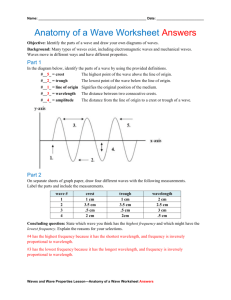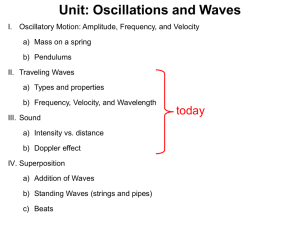Mechanical Waves
advertisement

PHYS1002 Physics 1 FUNDAMENTALS Module 3 OSCILLATIONS & WAVES Text Physics by Hecht Chapter 11 WAVES Mechanical Waves Sections: 11.1 11.2 11.3 11.4 11.5 Examples: 11.1 11.2 11.3 11.5 CHECKLIST Mechanical waves, progressive waves, traveling wave, medium Longitudinal and transverse waves Wave forms, wave pulse, wave train Wave function (x ± vt), wave speed v (m.s-1) period T (s), frequency f (Hz), angular frequency (rad.s-1), wavelength (m), angular wave number or propagation constant k (rad.m-1) T=1/f = 2 f k = 2 / v=f=/T=/k Harmonic wave wave function y(x, t) amplitude A phase traveling wave 2 y ( x, t ) A sin ( x v t ) A sin 2 ( x / t / T A sin(k x t ) (-) wave traveling + X direction, (+) wave traveling – X direction (11.3) phase velocity v = f (11.1) Energy A2 a02\p1\waves\waves110105.doc 4:07 AM 1 Transverse waves on strings wave speed v (m.s-1) v string tension FT (N) FT linear density = m / l (no derivation) (11.4) Speed of a mechanical wave is determined by the inertial and elastic properties of the medium and not in any way by the motion of the source. Reflection, Absorption and Transmission reflection at a fixed and free ends (Figs. 11.3, 11.14) transmission and refraction NOTES WAVES (, f) AND PARTICLES (p, E) two great concepts of classical physics Particles & Waves transfer of information and energy. Particle - “tiny” concentration of matter capable of transferring kinetic energy. Waves - Leonardo da Vinci - water waves - “it often happens that the wave flees the place of its creation, while the water does not”. Wave - broad distribution of energy filling the space through which it passes without the transfer of "material". TYPES OF WAVES Mechanical (governed by Newton’s Laws - travel through a medium) - sound, water, on strings, seismic. Electromagnetic - electromagnetic spectrum: self-propagating. In vacuum c = f = 3.00108 m.s-1 increasing frequency (energy) and decreasing wavelength Matter waves - “particles” show wave characteristics - interference = h/p f = E/h a02\p1\waves\waves110105.doc 4:07 AM 2 CLASSIFICATION OF WAVES A progressive or traveling wave is a self-sustaining disturbance of a medium that propagates from one region to another, carrying energy and momentum. The disturbance advances, but not the medium. Transverse waves - electromagnetic, waves on strings, seismic - vibration at right angles to direction of propagation of energy 18 t=T 16 14 12 10 8 6 4 t 2 t=0 0 -2 0 10 20 30 40 50 60 70 80 x The period (s) T of the wave is the time it takes for one wavelength of the wave to pass a point in space or the time for one cycle to occur. The frequency (Hz) f is the number of wavelengths that pass a point in space in one second. The wavelength (m) is the distance in space between two nearest points that are oscillating in phase (in step) or the spatial distance over which the wave makes one complete oscillation. The wave speed v (m.s-1) is the speed at which the wave advances v = x / t = / T = f a02\p1\waves\waves110105.doc 4:07 AM 3 Longitudinal (compressional) - sound, seismic - vibrations along or parallel to the direction of propagation. The wave is characterised by a series of alternate condensations (compressions) and rarefractions (expansion). t = T 16 14 12 10 8 6 4 t 2 t=0 0 0 10 20 30 40 50 60 70 80 x The period (s) T of the wave is the time it takes for one wavelength of the wave to pass a point in space or the time for one cycle to occur. The frequency (Hz) f is the number of wavelengths that pass a point in space in one second. The wavelength (m) is the distance in space between two nearest points that are oscillating in phase (in step) ) or the spatial distance over which the wave makes one complete oscillation. . The wave speed v (m.s-1) is the speed at which the wave advances v = x / t = / T = f The speed of a harmonic wave is the rate at which a point with constant phase moves and this speed is called the phase speed. a02\p1\waves\waves110105.doc 4:07 AM 4 DESCRIBING TRAVELING WAVES Wave function (disturbance) y(x,t) 2 y ( x, t ) A sin ( x v t ) A sin 2 ( x / t / T A sin(k x t ) + A wave travelling to the left - wave travelling to the right amplitude of the disturbance (max value measured from equilibrium position y = 0). The amplitude is always taken as a positive number. The energy associated with a wave is proportional to the square of wave’s amplitude. The intensity I of a wave is defined as the average power divided by the perpendicular area which I = Pavg / A it is transpoted. k angular wave number (wave number) or propagation constant or spatial frequency (rad.m-1) angular frequency (rad.s-1) (k x ± t) phase (rad) wavelength (m) y(0,0) = y(,0) = A sin(k ) = 0 T = 2 / k period (s) y(0,0) = y(0,T) = A sin(- T) = 0 v k = 2 T = 2 T = 2 / f = 2 / phase speed (m.s-1) v = x / t = / T = f = / k As the wave travels it retains its shape and therefore, its value of the wave function does not change i.e. (k x - t) = constant t increases then x increases, hence wave must travel to the right (in direction of increasing x). Differentiating w.r.t time t k dx/dt - = 0 dx/dt = v = / k As the wave travels it retains its shape and therefore, its value of the wave function does not change i.e. (k x + t) = constant t increases then x a02\p1\waves\waves110105.doc 4:07 AM 5 decreases, hence wave must travel to the left (in direction of decreasing x). Differentiating w.r.t time t k dx/dt + = 0 dx/dt = v = - / k Each “particle / point” of the wave oscillates with SHM particle displacement y(x,t) = A sin(k x - t) particle velocity y(x,t)/t = - A cos(k x - t) amplitude = ym particle acceleration ²y(x,t)/t² = -² A sin(k x - t) = -² y(x,t) amplitude = ² ym WAVE TRAVELLING THROUGH A MEDIUM - WAVE SPEED Wave -----> “particles” of the medium oscillate -----> particles kinetic energy (inertia) and medium has stored potential energy (stiffness/spring constant elasticity) v = (elastic property / inertial property) speed of wave speed of a wave along an ideal stretch string (wire) - tension FT and linear density (mass/length) v FT m L The speed of a mechanical wave is determined by the inertia and elastic properties of the medium and not in any wave by the motion of the source. The frequency of the wave is fixed entirely by whatever generates the wave hence wavelength determined by a02\p1\waves\waves110105.doc 4:07 AM = v/f 6 Problem A travelling wave is described by the equation y(x,t) = (0.003).cos( 20 x + 200 t ) where y and x are measured in metres and t in seconds What is the direction in which the wave is travelling? Calculate the following physical quantities: 1 2 3 4 5 6 7 8 9 angular wave number wavelength angular frequency frequency period wave speed amplitude particle velocity when x = 0.3 m and t = 0.02 s particle acceleration when x = 0.3 m and t = 0.02 s Solution y(x,t) = (0.003).cos(20x + 200t) The general equation for a wave travelling to the left is y(x,t) = A.sin(kx + t + ) 1 2 3 4 5 6 7 k = 20 m-1 = 2 / k = 2 / 20 = 0.31 m = 200 rad.s-1 =2f f = / 2 = 200 / 2 = 32 Hz T = 1 / f = 1 / 32 = 0.031 s v = f = (0.31)(32) = 10 m.s-1 amplitude A = 0.003 m x = 0.3 m t = 0.02 s 8 vp = y/t = -(0.003)(200).sin(20x + 200t) = -0.6sin(10) = +0.33 m.s-1 9 ap = vp/t = -(0.6)(200).cos(20x + 200t) = -120cos(10) = +101 m.s-2 a02\p1\waves\waves110105.doc 4:07 AM 7 BEHAVIOUR OF WAVES propagation of energy reflection refraction: transmission & absorption at an interface – If the incident wave is periodic, the transmitted wave has the same frequency but a different speed and hence different wavelength. superposition: diffraction & interference (wave not particle behaviour) polarisation (wave but particle property) Refection of a pulse - string with boundary condition at junction like a fixed end Incident pulse Transmitted pulse Reflected pulse Reflected wave rad (180°) out of phase with incident wave Heavy string exerts a downward force on light string when pulse arrives Refection of a pulse - string with boundary condition at junction like a free end Incident pulse Reflected pulse Reflected wave: in phase with incident wave, 0 rad or 0°C phase difference a02\p1\waves\waves110105.doc 4:07 AM Transmitted pulse Heavy string pulls light string up when pulse arrives, string stretches then recovers producing reflected pulse 8 SOUND WAVES Sound is caused by mechanical vibrations that are transmitted through a medium. In air the vibrations are purely longitudinal. But in solids, the sound wave can be longitudinal, transverse or a combination of both. The speed of sound is air depends upon its temperature and humidity. For dry air at a temperature of 0 °C it is about 330 m.s-1. The speed of sound through solids is much higher eg steel v ~ 6000 m.s-1. The audible range of frequencies that the ear is sensitive to are in the range from 20 to 20 000 Hz. Sound waves for frequencies below this range are referred to as infrasound (airplanes. elephants, thunderstorms, fast moving cars, very loud music) and sound waves with frequencies greater than 20 000 Hz are called ultrasonic sound waves or ultrasound. Ultrasound Ultrasonic waves are produced by piezoelectric transducers and transmitted to an object via a liquid film such as water or oil. Ultrasonic beams can be directed and focused. They are partially reflected at voids, cracks and interfaces between materials which have different density or elasticity. The echoes which return from the object boundaries or discontinuities can be used to measure thickness and to detect flaws and image the interior. Waves reflect effectively off objects that are at least as large as one wavelength – ultrasonic imaging, navigation by dolphins & bats, autofocus cameras. To image small objects the wavelength has to be very small (very high frequency sound waves). Ultrasonic waves are used widely in medicine for diagnosis (imaging) and treatment (destroying kidney stones & tumors). Non-destructive testing of materials – flaws and crackes Cleaning – jewellery, golf clubs, machine parts Flow of blood through the placenta a02\p1\waves\waves110105.doc 4:07 AM 9 SEISMIC WAVES (EARTHQUAKES) S waves (shear waves) – transverse waves that travel through the body of the Earth. However they can not pass through the liquid core of the Earth. Only longitudinal waves can travel through a fluid – no restoring force for a transverse wave. v ~ 5 km.s-1. P waves (pressure waves) – longitudinal waves that travel through the body of the Earth. v ~ 9 km.s-1. L waves (surface waves) – travel along the Earth’s surface. The motion is essentially elliptical (transverse + longitudinal). These waves are mainly responsible for the damage caused by earthquakes. Tsunami If an earthquakes occurs under the ocean it can produce a tsunami (tidal wave). Sea bottom shifts ocean water displaced water waves spreading out from disturbance very rapidly v ~ 500 km.h-1, ~ (100 to 600) km, height of wave ~ 1m waves slow down as depth of water decreases near coastal regions waves pile up gigantic breaking waves ~30+ m in height. 1883 Kratatoa - explosion devastated coast of Java and Sumatra 1896 Japan – 27 000 people killed, 10 000 homes destroyed a02\p1\waves\waves110105.doc 4:07 AM 10





